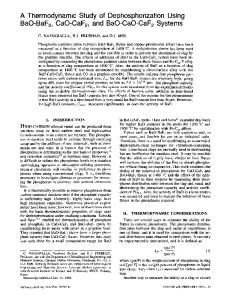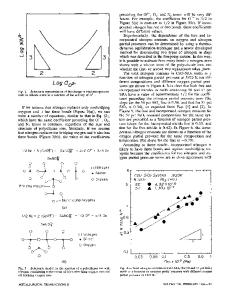Ultrathin oxide films: CaO layers on BaO and SrO
- PDF / 526,571 Bytes
- 6 Pages / 612 x 792 pts (letter) Page_size
- 94 Downloads / 277 Views
1148-PP07-07
Ultrathin oxide films: CaO layers on BaO and SrO Chris E. Mohn1,2,3, Neil L. Allan2 and John H. Harding4 1
Department of Chemistry and Centre for Materials Science and Nanotechnology, University of Oslo, Postbox 1033, Blindern, N-0315 Oslo, Norway 2
School of Chemistry, University of Bristol, Cantock’s Close, Bristol BS8 1TS, U.K.
3
Laboratoire des Colloïdes, Verres et Nanomatériaux, UMR 5587, Université Montpelier II-
CNRS, 34095, Montpellier, France 4
Department of Engineering Materials, University of Sheffield, Sir Robert Hadfield Building, Mappin Street, Sheffield S1 3JD
ABSTRACT Prompted by renewed interest in the crystalline oxides-on-semiconductors interface, periodic density functional theory and atomistic simulation techniques are used to examine the formation of a layer of CaO on BaO and SrO substrates. We examine how CaO islands which form at coverages less than 100% adjust to the substrate in which the cation-anion separation is substantially larger than in CaO itself. All Ca-O bond lengths in the island are shorter than that in bulk CaO. Corner O atoms in the islands are associated with particularly short Ca-O bond lengths, and the shape of the islands is dominated by (100) edges. Once formed, islands with intact edges will remain intact. Interactions between islands at larger coverages are also investigated and we see the formation of characteristic elliptical gaps and loops.
INTRODUCTION At the atomic level, assembly and fabrication requires precise control of interfaces and device manufacture often requires applying such control to the growth of thin films supported on a host substrate [1]. Techniques such as molecular beam epitaxy (MBE), chemical vapour deposition (CVD) and pulsed laser deposition (PLD) are all capable of producing structures strikingly different from bulk systems, thus leading to new nanoscale materials and devices. When there are marked differences between bulk and nanoscale, theory can assist in the interpretation of the experimental data (from, for example, RHEED or TEM), in the prediction of structure and stability [2] and in unravelling the complex processes involved in film growth over larger length and time scales. Thin oxide films are important in areas from catalysis to the development of new oxide gate dielectrics [3]. Alkaline earth oxides possess dielectric constants high enough to be useful as gate dielectrics. Results for both BaO and SrO are reported, but we concentrate on layers of CaO grown on a BaO substrate, prompted by MBE studies of the growth of these oxides [4]. There is a large increase in size from Ca2+ to Ba2+, which have ionic radii (six-coordinate) of 1.00 Å and 1.35 Å respectively [5]). In the discussion which follows it is also useful to bear in
mind the bulk lattice parameters of CaO and BaO of 4.81 Å and 5.53 Å respectively, a mismatch of approximately 13%. Thus this system is particularly appropriate for a theoretical investigation of heteroepitaxial matching. In this first study, we examine clusters or ‘islands’ of CaO on th
Data Loading...










